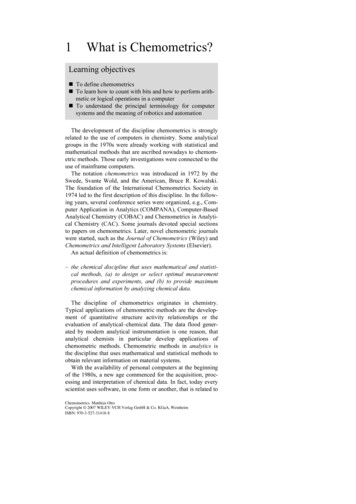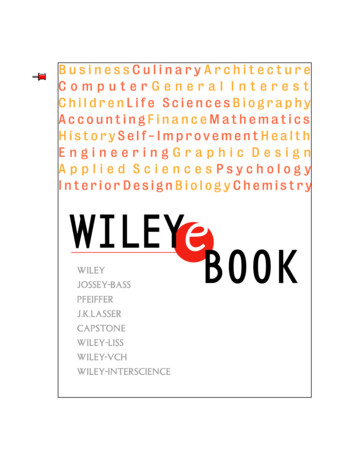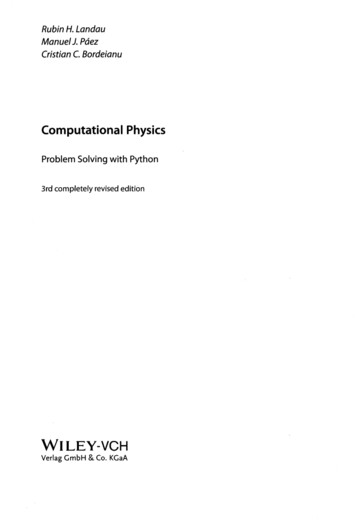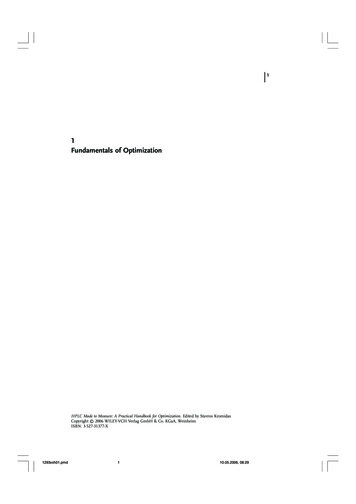
Transcription
1What is Chemometrics?Learning objectives" To define chemometrics" To learn how to count with bits and how to perform arithmetic or logical operations in a computer" To understand the principal terminology for computersystems and the meaning of robotics and automationThe development of the discipline chemometrics is stronglyrelated to the use of computers in chemistry. Some analyticalgroups in the 1970s were already working with statistical andmathematical methods that are ascribed nowadays to chemometric methods. Those early investigations were connected to theuse of mainframe computers.The notation chemometrics was introduced in 1972 by theSwede, Svante Wold, and the American, Bruce R. Kowalski.The foundation of the International Chemometrics Society in1974 led to the first description of this discipline. In the following years, several conference series were organized, e.g., Computer Application in Analytics (COMPANA), Computer-BasedAnalytical Chemistry (COBAC) and Chemometrics in Analytical Chemistry (CAC). Some journals devoted special sectionsto papers on chemometrics. Later, novel chemometric journalswere started, such as the Journal of Chemometrics (Wiley) andChemometrics and Intelligent Laboratory Systems (Elsevier).An actual definition of chemometrics is:– the chemical discipline that uses mathematical and statistical methods, (a) to design or select optimal measurementprocedures and experiments, and (b) to provide maximumchemical information by analyzing chemical data.The discipline of chemometrics originates in chemistry.Typical applications of chemometric methods are the development of quantitative structure activity relationships or theevaluation of analytical–chemical data. The data flood generated by modern analytical instrumentation is one reason, thatanalytical chemists in particular develop applications ofchemometric methods. Chemometric methods in analytics isthe discipline that uses mathematical and statistical methods toobtain relevant information on material systems.With the availability of personal computers at the beginningof the 1980s, a new age commenced for the acquisition, processing and interpretation of chemical data. In fact, today everyscientist uses software, in one form or another, that is related toChemometrics. Matthias OttoCopyright 2007 WILEY-VCH Verlag GmbH & Co. KGaA, WeinheimISBN: 970-3-527-31418-8
21 What is Chemometrics?mathematical methods or to processing of knowledge. As aconsequence, the necessity emerges for a deeper understandingof those methods.The education of chemists in mathematics and statistics isusually unsatisfactory. Therefore, one of the initial aims ofchemometrics was to make complicated mathematical methodspracticable. Meanwhile, the commercialized statistical and numerical software simplifies this process, so that all importantchemometric methods can be taught in appropriate computerdemonstrations.Apart from the statistical–mathematical methods, the topicsof chemometrics are also related to problems of the computerbased laboratory, to methods for handling chemical or spectroscopic databases and to methods of artificial intelligence.In addition, chemometricians contribute to the developmentof all these methods. As a rule, these developments are dedicated to particular practical requirements, such as the automaticoptimization of chromatographic separations or in prediction ofthe biological activity of a chemical compound.1.1 The Computer-basedLaboratoryNowadays the computer is an indispensable tool in researchand development. The computer is linked to analytical instrumentation; it serves as a tool for acquiring data, for word processing and for handling databases and quality assurance systems. In addition, the computer is the basis for modern communication techniques such as electronic mail or video conferences. In order to understand important principles of computerusage some fundamentals are considered here, i.e., coding andprocessing of digital information, the main components of acomputer, programming languages, computer networking andautomation processes.Analog and digital dataThe use of digital data provides several advantages over theuse of analog data. Digital data are less noise sensitive. Theonly noise arises from round-off errors due to finite representation of the digits of a number. They are less prone to, for instance, electrical interferences and they are compatible withdigital computers.
1.1 The Computer-based Laboratory3Fig. 1-1. Signal dependence ontime of an analog (a) and a digitaldetector (b)As a rule, primary data are generated as analog signals eitherin a discrete or a continuous mode (Fig. 1-1). For example,monitoring the intensity of optical radiation by means of a photocell provides a continuous signal. Weak radiation, however,could be monitored by detecting individual photons by a photomultiplier.Usually, the analog signals generated are converted into digital data. This is carried out by an analog-to-digital converter asexplained below.Binary versus decimal number systemIn a digital measurement, the number of pulses occurringwithin a specified set of boundary conditions is counted. Theeasiest way to count is to have the pulses represented as binarynumbers. In this way only two electronic states are required. Torepresent the decimal numbers from 0 to 9 one would need 10different states. Typically, the binary numbers 0 and 1 are represented electronically by voltage signals of 0.5 V and 5 V, respectively. Binary numbers characterize coefficients of the power of2, so that any number of the decimal system can be described.Example 1-1: Binary number representationThe decimal number 77 is expressed as binary number by1001101, i.e.,101 26 0 2564 000 24 011 23 811 22 400 21 011 20 1 77Table 1-1 provides further relationships between binary anddecimal numbers. Every binary number is composed of individual bits (binary digits). The digit lying farthest to the right istermed the least significant digit and the one on the left is themost significant digit.Table 1-1. Relationship betweenbinary and decimal numbersBinary 01000000Decimal number01234567891013163264
41 What is Chemometrics?How are calculations done using binary numbers? Arithmeticoperations are similar, but simpler than those for decimal numbers. In addition, for example, four combinations are feasible:0011 0 1 0 101110Note that for addition of the binary numbers 1 plus 1, a 1 iscarried over to the next higher power of 2.Example 1-2: Calculation with binary numbersConsider addition of 21 5 in the case of a decimal (a)and of a binary number (b):a.21 526b.10101 10111010Apart from arithmetic operations in the computer, logicalreasoning is necessary too. This might be in the course of analgorithm or in connection with an expert system. Logical operations with binary numbers are summarized in Table 1-2.Table 1-2. Truth values for logical connectives of predicates p and qbased on binary numbers. 1 True, 0 falsep1100q1010p AND q1000p OR q1110IF p THEN q1011NOT p0–1–It should be mentioned that a very compact representation ofnumbers is based on the hexadecimal number system. However, hexadecimal numbers are easily converted to binary data,so the details need not be explored here.Digital and analog convertersAnalog-to-digital converters (ADCs)In order to benefit from the advantages of digital dataevaluation, the analog signals are converted into digital ones.An analog signal consists of an infinitely dense sequence ofsignal values in a theoretically infinite small resolution. Theconversion of analog into digital signals in the ADC results in a
1.1 The Computer-based Laboratory5definite reduction of information. For conversion, signal valuesare sampled in a predefined time interval and quantified in an-ary raster (Fig. 1-2). The output signal is a code word consisting of n bits. Using n bits, 2n different levels can be coded, e.g.,an 8-bit ADC has a resolution of 28 256 amplitude levels.Fig. 1-2. Digitization of an analogsignal by an analog-to-digitalconverter (ADC)Digital-to-analog converters (DACs)Converting digital into analog information is necessary if anexternal device is to be controlled or if the data have to be represented by an analog output unit. The resolution of the analogsignal is determined by the number of processed bits in the converter. A 10-bit DAC provides 210 1024 different voltage increments. Its resolution is then 1/1024 or approximately 0.1%.Computer terminologyRepresentation of numbers in a computer by bits has alreadybeen considered. The combination of 8 bits is called a byte. Aseries of bytes arranged in sequence to represent a piece of datais termed a word. Typical word sizes are 8, 16, 32 or 64 bits, or1, 2, 4, and 8 bytes.Words are processed in registers. A sequence of operationsin a register enables algorithms to be performed. One or several algorithms make up a computer program.The physical components of a computer form the hardware.Hardware includes the disk and hard drives, clocks, memoryunits and registers for arithmetic and logical operations. Programs and instructions for the computer, including the tapesand disks for their storage, represent the software.Components of computersCentral processing units and busesA bus consists of a set of parallel conductors that forms amain transition path in a computer.
61 What is Chemometrics?The heart of a computer is the central processing unit (CPU).In a microprocessor or minicomputer, this unit consists of ahighly integrated chip.The different components of a computer, its memory and theperipheral devices, such as printers or scanners, are joined bybuses. To guarantee rapid communication among the variousparts of a computer, information is exchanged on the basis of adefinitive word size, e.g., 16 bits, simultaneously over parallellines of the bus. A data bus serves the exchange of data into andout of the CPU. The origin and the destination of the data in thebus are specified by the address bus. For example, an addressbus with 16 lines can address 216 65536 different registers orother locations in the computer or in its memory. Control andstatus informations to and from the CPU are administrated in thecontrol bus. The peripheral devices are controlled by an externalbus system, e.g., an RS-232 interface for serial data transfer orthe IEEE-488 interface for parallel transfer of data.MemoryThe microcomputer or microprocessor contains typically twokinds of memory: random access memory (RAM) and readonly memory (ROM). The term RAM is somewhat misleadingand historically reasoned, since random access is feasible forRAM and ROM alike. The RAM can be used to read and writeinformation. In contrast information in a ROM is written once,so that it can be read, but not reprogrammed. ROMs are neededin microcomputers or pocket calculators in order to performfixed programs, e.g., for calculation of logarithms or standarddeviations.Larger programs and data collections are stored in bulk storage devices. In the beginning of the computer age, magnetictapes were the standard here. Nowadays tapes are still used forarchiving large data amounts. Routinely, 3.5′′ disks (formerly5¼′′) are used providing a storage capacity of 1.44 MB. In addition, every computer is equipped with a hard disk of at least20 MB, and up to several GB. The access time to retrieve thestored information is in the order of a few milliseconds.At present, the availability of optical storage media is increasing. CD-ROM drives serve for reading large programs ordatabases. An optical hard disk can be used either to read orwrite information. Although optically based bulk storage devices have slower access times than magnetic bulk storage media, their storage capacity is larger.Input/output-systemsCommunication with the computer is carried out by inputoutput (I/O) operations. Typical input devices are the keyboard,magnetic tapes and disks or the signals of an analytical instru-
1.1 The Computer-based Laboratory7ment. Output devices are screens, printers and plotters, aswell as tapes and disks. To convert analog information intodigital or vice versa, the above-mentioned ADCs or DACs areused.ProgramsProgramming a computer at 0 and 1 states or bits is possibleusing machine code. Since this kind of programming is rathertime consuming, higher level languages have been developedwhere whole groups of bit-operations are assembled. However,these so-called assembler languages are still difficult to handle.Therefore, high-level algorithmic languages, such asFORTRAN, BASIC, PASCAL or C, are more common in analytical chemistry. With high-level languages, the instructionsfor performing an algorithm can easily be formulated in a computer program. Thereafter, these instructions are translated intomachine code by means of a compiler.For logical programming, additional high-level languagesexist, e.g., LISP (List Processing language) or PROLOG (Programming in Logic). Further developments are found in socalled Shells, which can be used directly for building expertsystems.NetworkingA very effective communication between computers, analyticalinstruments, and databases is based on networks. There are local nets, e.g., within an industrial laboratory as well as nationalor worldwide networks. Local area networks (LANs) are usedFig. 1-3. Local area network(LAN) to connect analyticalinstruments, a robot and alaboratory-and-informationmanagement system (LIMS)
81 What is Chemometrics?to transfer information about analysis samples, measurements,research projects, or in-house databases. A typical LAN isdemonstrated in Fig. 1-3. It contains a laboratory-and-information management system (LIMS), where all informationabout the sample or the progresses in a project can be storedand further processed (cf. Section 7.1).Worldwide networking is feasible, e.g., via Internet orCompuserve. These nets are used to exchange electronic mails(e-mail) or data with universities, research institutions, or industry.Robotics and automationApart from acquiring and processing analytical data, the computer can also be used to control or supervise automatic procedures. To automate manual procedures, a robot is applied. Arobot is a reprogrammable device that can perform a task morecheaply and effectively than a person.Typical geometric shapes of a robot arm are sketched inFig. 1-4. The anthropomorphic geometry (Fig. 1-4A) is derivedfrom the human torso, i.e., there is a waist, shoulder, elbow,and wrist. Although this type of robot is mainly found in theautomobile industry, it can also be used for manipulation ofliquid or solid samples.Fig. 1-4. Anthropomorphic (A)and cylindrical (B) geometry ofrobot armsIn the chemical laboratory, the cylindrical geometry dominates (Fig. 1-4B). The revolving robot arm can be moved inhorizontal and vertical directions. Typical operations of a robotare: Manipulation of test tubes or glass ware around the roboticwork area. Weighing, for determination of a sample amount or forchecking unit operations, e.g., addition of a solvent. Liquid handling, in order to dilute or add reagent solutions. Conditioning of a sample by heating or cooling. Separations based on filtrations or extractions.
1.2 Statistics and Data Interpretation Measurements by analytical procedures, such as spectrophotometry or chromatography. Control and supervision of the different analytical steps.Programming of a robot is based on software dedicated tothe actual manufacture. The software consists of elements tocontrol the peripheral devices (robot arm, balance, pumps), toswitch the devices on and off, and to provide instructions onthe basis of logical structures, e.g., IF–THEN rules.Alternatives for automation in a laboratory are discrete analyzers and flowing systems. By means of discrete analyzers,unit operations such as dilution, extraction or dialyses can beautomated,. Continuous flow analyzers or flow injection analyses serve similar objectives for automation, e.g., for the determination of clinical parameters in blood serum.The transfer of manual operations to a robot or an automatedsystem provides the following advantages: high productivity and/or minimization of costs; improved precision and trueness of results; increased assurance for performing laboratory operations; easier validation of the different steps of an analytical procedure.The increasing degree of automation in the laboratory leadsto more and more measurements that are available online in thecomputer and have to be further processed by chemometricdata evaluation methods.1.2 Statistics andData InterpretationTable 1-3 provides an overview of chemometric methods.The main emphasis is on statistical–mathematical methods.Random data are characterized and tested by the descriptiveand inference methods of statistics, respectively. Their importance increases in connection with the aims of quality controland quality assurance. Signal processing is carried out bymeans of algorithms for smoothing, filtering, derivation and integration. Transformation methods such as the Fourier or Hadamard transformations also belong in this area.Efficient experimentation is based on the methods of experimental design and its quantitative evaluation. The latter can beperformed by means of mathematical models or graphical representations. Alternatively, sequential methods are applied, such asthe simplex method, instead of these simultaneous methods of9
101 What is Chemometrics?Table 1-3. Chemometric methods for data evaluation and interpretationDescriptive and inference statisticsSignal processingExperimental designModelingOptimizationPattern recognitionClassificationArtificial intelligence methodsImage processingInformation and system theoryexperimental optimization,. There, the optimum conditions arefound by systematic search for the objective criterion, e.g., themaximum yield of a chemical reaction, in the space of all experimental variables.To find patterns in data and to assign samples, materials or ingeneral, objects, to those patterns, multivariate methods of dataanalysis are applied. Recognition of patterns, classes or clustersis feasible with projection methods, such as principle componentanalysis or factor analysis, or with cluster analysis. To constructclass models for classification of unknown objects we will introduce discriminant analyses.To characterize the information content of analytical procedures, information theory is used in chemometrics.1.3 Computer-basedInformation Systems/Artificial IntelligenceA further subject of chemometrics is the computer-basedprocessing of chemical structures and spectra.There, it might be necessary to extract a complete or partialstructure from a collection of molecular structures, or to comparean unknown spectrum with the spectra of a spectral library.For both kinds of queries, methods for representation andmanipulation of structures and spectra in databases are needed.In addition, problems of data exchange formats, e.g., between ameasured spectrum and a spectrum of a database, are to be decided.If no comparable spectrum is found in a spectral library, thenmethods for spectra interpretation become necessary. For interpretation of atomic and molecular spectra, in principle, all the
1.4 General Readingstatistical methods for pattern recognition are appropriate (cf.Section 1.2). In addition, methods of artificial intelligence areused. They include methods of logical reasoning and tools fordeveloping expert systems. Apart from the methods of classicallogic in this context also methods of approximate reasoningand of fuzzy logic can be exploited. These interpretation systems constitute methods of knowledge processing in contrast todata processing based on mathematical–statistical methods.Knowledge acquisition is mainly based on expert knowledge, e. g., the infrared spectroscopist is asked to contribute hisknowledge in the development of an interpretation system forinfrared spectra. Additionally, methods are required for automatic knowledge acquisition in form of machine learning.The methods of artificial intelligence and machine learningare not restricted to the interpretation of spectra. They also canbe used to develop expert systems, e.g., for the analysis ofdrugs or the synthesis of an organic compound.Novel methods are based on biological analogs, such as neural networks and evolutionary strategies, e. g., genetic algorithms. Future areas of research for chemometricians will include the investigation of fractal structures in chemistry and ofmodels based on the theory of chaos.1.4 General ReadingSharaf, M. A., Illman, D. L., Kowalski, B. R., Chemometrics,Chemical Analysis Series Vol. 82: Wiley, New York, 1986.Massart, D. L., Vandeginste, B. G. M., Deming, S. N., Michotte, Y., Kaufmann, L., Chemometrics–a Textbook: Elsevier, Amsterdam, 1988.Questions and Problems1. Calculate the resolution for 10-, 16- and 20-bit analog-todigital converters.2. How many bits are stored in an 8-byte word?3. What is the difference between procedural and logical programming languages?4. Discuss typical operations of an analytical robot.11Methods based on fuzzy theory,neural nets and evolutionarystrategies are denoted softcomputing.
121 What is Chemometrics?
decimal numbers. Every binary number is composed of indi-vidual bits (binary digits). The digit lying farthest to the right is termed the least significant digit and the one on the left is the most significant digit. Table 1-1. Relationship between binary and decimal numbers Binary number Decimal number 00 11 10 2 11 3 100 4 101 5 110 6 111 7 .










